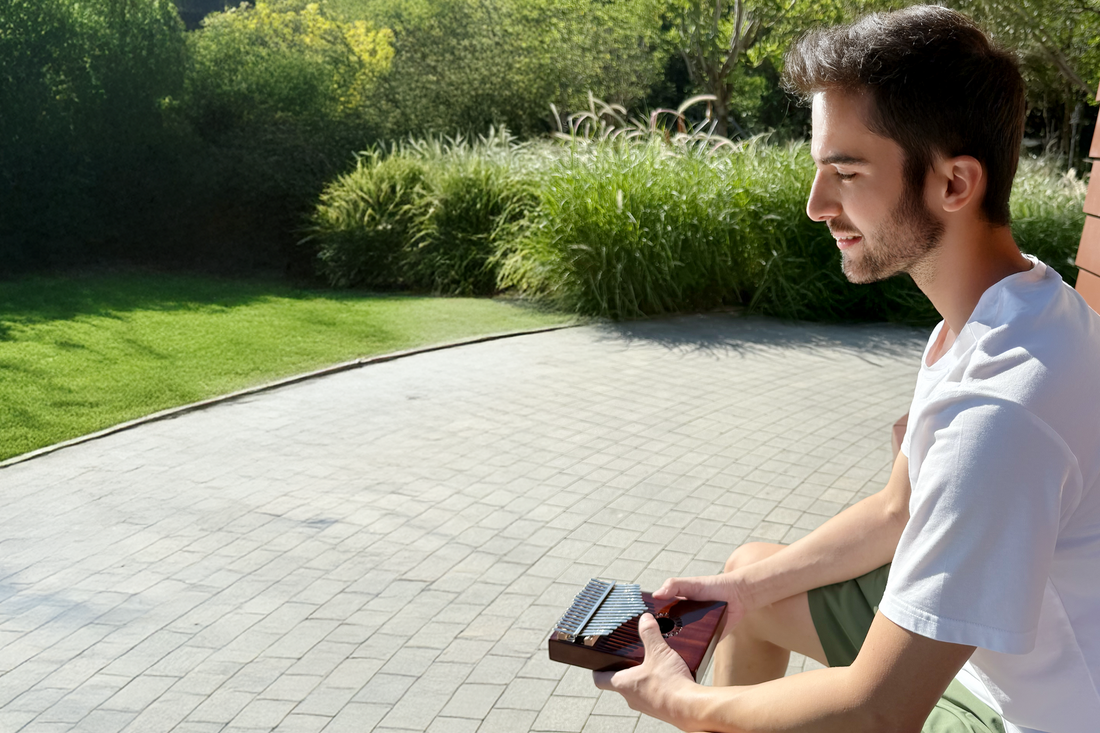
My Journey Beyond the Notes
Share
I never considered myself particularly musical. Growing up in İzmir, my world was filled with sounds—car horns, market vendors, the distant call to prayer—but not the kind that came from instruments. My cousins were the ones who took piano lessons or played the guitar at family gatherings. I was more of a quiet observer, someone who appreciated music but never imagined himself making it.
That changed the day I stumbled upon a video of someone playing the kalimba on a mountaintop. The sound was unlike anything I’d heard before. It was soft, earthy, and somehow... honest. There was something incredibly raw about it—no grand performance, no complex chords—just a pair of thumbs dancing over metal keys, each note ringing like a thought whispered aloud.
It didn’t take long for me to search online, read about the instrument, and finally buy one. It was a small model, made of acacia wood, with 17 keys and a warm, golden-brown finish.
At first, I followed the sheet music religiously. I printed out number charts, watched tutorials on YouTube, and practised late at night when the city finally fell quiet. I learned simple melodies and a few Turkish lullabies that reminded me of my childhood. I enjoyed it. There was structure, something reassuring in knowing what note came next. The predictability made me feel in control.
But after a few months, something shifted. I began to feel less excitement when playing the same songs again and again. I found myself rushing through them, almost like checking items off a list. There was little joy, no sense of discovery. The kalimba had started to feel like a device instead of a companion.
One evening, I took it with me to a park near the sea. It wasn’t planned—I just had it in my bag. I sat on a bench overlooking the Aegean, the sky dipped in orange and lilac hues. The sound of the waves, the rustling of the trees, the distant chatter of people walking their dogs—it all formed a sort of natural music. I pulled the kalimba out and held it for a while, just listening.
Then, without thinking, I played a note. Just one. Then another. There was no melody I recognised, no chart to guide me. I played what felt right in that moment. My thumbs moved slowly, unsure at first, but soon I found myself lost in a rhythm that seemed to come not from my mind, but somewhere deeper—my chest, my stomach, even my breath. The breeze, the scent of salt in the air, the mood of the sky—it all entered the music.
That evening changed everything.
From then on, I began to let go of sheet music. I still referred to it now and then, but I stopped letting it control the experience. Instead, I began using my surroundings and emotions as my guide. If it was a grey, rainy morning, my playing would be soft, almost melancholic. On sunny days, I played more cheerfully, with a rhythm that felt like footsteps skipping on cobblestone.
I realised that the kalimba didn’t need to be about performance or perfection. It was about presence. About tuning into where I was, both physically and emotionally. The instrument, so simple in design, became a mirror. It didn’t judge me. It didn’t demand technical brilliance. It only asked me to be honest.
One afternoon, I was playing under a tree near the university. I had just finished an exhausting exam and felt completely drained. I didn’t even think I had the energy to play. But I sat down, took out the kalimba, and began to press the keys without thinking. The music that came out was slow and slightly dissonant. It wasn’t pretty, but it was real. A stranger walking past stopped, smiled, and sat on the grass nearby, listening. He didn’t say anything, but when I finished, he clapped softly, nodded, and left.
That simple exchange stayed with me for weeks. I had spoken with no words, yet something had been shared, acknowledged. It was then that I began to understand: music isn’t always about harmony. Sometimes it’s about tension, release, and reflection.
As time passed, my confidence grew—not in the sense of being “good,” but in trusting my instincts. I started recording my improvisations on my phone, not for social media, but for myself. I’d listen back and hear things I hadn’t noticed before—a pattern, an emotion I didn’t even realise I’d felt. It was like journaling without words.
Eventually, I began bringing the kalimba with me on small trips around Turkey. On a hike in Cappadocia, I played on a rock ledge as hot air balloons drifted silently across the sky. In a quiet village in the Black Sea region, I played by a stream where old women washed vegetables in woven baskets. In Istanbul, I played on a ferry crossing the Bosphorus as seagulls cried above and minarets passed slowly by.
Each location gave the music its own flavour. And in each place, someone would stop to listen. Sometimes children. Sometimes elderly men who asked me what the instrument was. Once, a tourist from Germany filmed me and said she had never heard anything like it. I didn’t have the words to fully explain what I was doing, but it didn’t matter. The kalimba spoke for me.
Now, looking back, I see how much has changed since I first picked up the instrument. I still don’t know much about keys or scales. I still make mistakes. But I’ve learned that music doesn’t always need a map. Sometimes, the best melodies come from wandering.
I think we live in a world obsessed with perfection—flawless execution, polished performances, rules and rewards. But the kalimba taught me the value of imperfection. It gave me permission to simply be. To create for the sake of feeling. To connect, not impress.
Whenever I play now, especially in new places, I feel like I’m offering a piece of myself, and in return, I receive a piece of the world. A smile, a gesture, a breeze that seems to answer my tune. It’s a conversation—me, the instrument, and the environment.
I don’t know if I’ll ever become a “real musician.” But I know this: when I play, I feel alive. And in a time where so much feels uncertain and disconnected, that feeling is more than enough.
So if you ever see someone sitting on a park bench or a seaside wall in Turkey or elsewhere, playing a small wooden instrument with metal keys, come closer. Not to ask questions or take pictures, but just to listen. You may not understand the notes, but if you listen closely, you might hear something familiar—something human.
Because that’s what the kalimba gives us. Not just sound, but space. Space to feel. Space to connect. Space to simply be.
